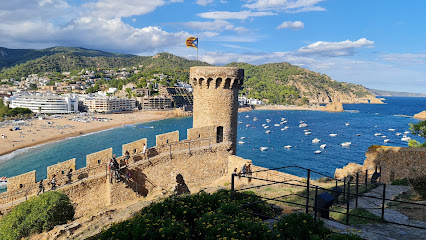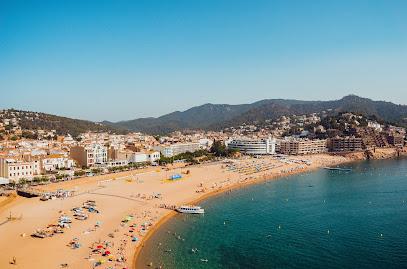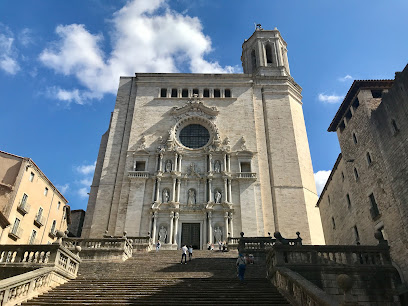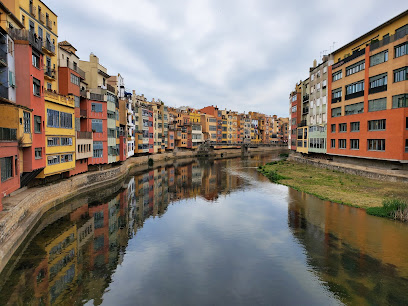Visit Tossa De Mar and Girona for 8 Hours from Barcelona
Highlights
- Visit the beautiful village of Tossa de Mar
- Explore the historic Castillo de Tossa de Mar
- Relax on the enchanting Tossa de Mar beach
- Discover the city of Girona, known for its Game of Thrones filming locations
- Marvel at the stunning Girona Cathedral
-
Duration 8 hours
-
Private transportation
-
Bottled water included
-
Air-conditioned vehicle
-
Baby chairs available on demand
-
Expert English and Spanish guide
Experience the best of the Costa Brava and Girona on this 8-hour tour departing from Barcelona. Immerse yourself in the charm of Tossa de Mar, a picturesque village on the Costa Brava, famous for its stunning beaches and captivating history. Explore the magnificent Castillo de Tossa de Mar, a medieval walled town that offers panoramic views of the coast. Then, venture to Girona, a city that blends Romanesque, Gothic, and Baroque architecture. Walk through its old town, visit the famous Girona Cathedral, and marvel at the colorful Houses of Oñar. Don't miss the chance to stroll along the Passeig de la Muralla, Girona's Roman wall, and experience the city's rich history. Travel in comfort and style in our luxury cars, driven by professional drivers who will ensure your trip is safe and unforgettable. Book now and create memories that will last a lifetime.
At a Glance
-
Free cancellation
-
8 hours
-
Instant Confirmation
-
Available in English, Spanish; Castilian
-
Mobile voucher
-
Small Group tour
-
Guided
-
Family friendly
Explore the stunning Tossa de Mar and historic Girona in an unforgettable 8-hour private tour from Barcelona, complete with comfortable transportation.
Included
-
In-vehicle air conditioning
-
Bottled water
-
Private transportation
-
Baby Chairs and Boosters for Children (On Demand)
Excluded
-
Lunch
-
Tickets for attractions
Pickup
Check if pick-up is available from your location, you will select during checkout (providers may allow other pickup locations)
What to expect

Beautiful village on the Costa Brava. Internationally known thanks to the movie "Pandora and the Flying Dutchman" (1951), starring Ava Gardner. Her stay in the village is remembered with a bronze statue in her honor.

Castle of Tossa de Mar. Walled enclosure and Wall of Tossa de Mar. In 1931, the complex was declared National Historic Artistic Monument. Located at the Vila Vella of Tossa, it is the only example of a medieval walled town that is still standing in the Catalan shore.
Platja Gran

Literally "Huge Beach". Enchanting beach close to Vila Vella.
Girona
Girona is crossed by the rivers Ter, Güell, Galligans, and Oñar. It is located 75 meters above sea level. The city is also known because its old town was used as a set for some episodes of "Game of Thrones." Its old town is delimited by the Paseo de la Muralla, the coastal walkway of the old Carolingian walls (9th century) and the late Middle Ages (14th and 15th centuries). Its most memorable monuments include El Call, one of the best preserved old Jewish quarters in Spain, as well as the colorful Casas del Oñar, situated on the banks of the river Oñar and very close to the Cathedral of Santa Maria, which has the widest Gothic nave in the world.

The Cathedral of Santa Maria of Girona, built between the 9th and the 18th century, includes three main architectural styles: Romanesque, Gothic and Barroque. Its cloister is Romanesque, with interesting decorated capitals. Its wide Gothic nave stands out for being the widest Gothic nave and the second widest in the world, just after Saint Peter's Basilica in the Vatican. To access the temple, there is a majestic staircase built in the time of Bishop Pontich, between 1686 and 1699, with ninety steps, divided in three sections, and a stone balustrade on its sides. The Cathedral's main facade is Baroque.
Casc antic Ullà
The old town of Girona, the heart of the Roman city of Gerunda, contains the most relevant artistic heritage of the city. It's limited by immense traces of the old wall, which can be traversed by the Paseo Arqueológico (Archeological Walk), which has a beautiful lookout over the city. In addition to civil buildings such as the House of the Archdeacon and the Episcopal Palace, the old town also has important religious buildings. For instance, the Romanesque Monastery of San Pedro de Galligans, the Chapel of San Nicolás, or the Basilica of San Félix, with its slender and singular gothic tower truncated by a lightning. In the square of the cathedral, we can also find relevant monuments like the Casa Pastors, a Renaissance building that today works as the courthouse, and the Pia Almoina.
Cases de l'Onyar

Las Casas del Oñar (Houses of Oñar), also known as the Houses of the River or Hanging Houses, are those which have their facades facing the Oñar river. They are located between la Rambla and Calle Argentería in the old town of Girona. This complex is included in the Inventario del Patrimonio Arquitectónico de Cataluña. All their river facades are painted following the color palette conferred by Enric Ansesa, Jaume Faixó and the architects J. Fuses and J. Viader. One of the most relevant houses is the Casa Masó (Masó House), the birthing house of Rafael Masó i Valentí, an architect from Girona. It is located in the number 29 of the Calle Ballesteries of Girona; it is a symbol of the evolution of the artistic movement "Noucentisme" in the city. From 2006, it houses the headquarters of la Fundación Rafael Masó (the Rafael Masó Fundation). Its facade can be identified thanks to its white and blue colors that made it stand out over the rest.
Patronat Call de Girona
The Jewish History Museum of Girona, is located in the Centro Bonastruc ça Porta, in the middle of the old Jewish quarter of Girona. The building is situated where the old synagogue and its annexes used to be in the 15th century. The main goal of this museum is to preserve and share the history of the Jewish communities of Catalonia, that during the Middle Ages took an important part and contributed to the historical trajectory and the cultural and scientific development of the country.
Passeig de la Muralla
Girona's Roman wall was built to defend the city from invading armies. Being a border city, it had a strategic geographical location. The Romans raised in the 1st century B.C. a mighty fortress that ran around an almost triangular perimeter. It was a kind of acropolis, la Fuerza Vieja, and it was very well protected by walls built with large blocks of stone. It is the first enclosure of the city of Girona, which remained unchanged until the 10th Century.
The experience can be subject to change due to bad weather or unforseen circumstances. We always endeavour to give you the best possible experience.
Additional Information
-
Infants and small children can ride in a pram or stroller
-
Public transportation options are available nearby
-
Specialized infant seats are available
-
Suitable for all physical fitness levels
What our experts say
-
Try local seafood at El Celler de Can Roca.
-
Don't miss the stunning views from Tossa Castle.
-
Visit the Jewish Quarter in Girona for history.
-
Capture photos at the colorful Casas del Oñar.
-
Plan your visits to avoid peak hours.
More About this Experience
Introduction
Indulge in a perfect day trip from Barcelona by experiencing the charming village of Tossa de Mar and the captivating city of Girona. Immerse yourself in the beauty of the Costa Brava as you explore picturesque coastal scenery and historical architecture. This 8-hour tour promises an unforgettable adventure filled with breathtaking moments and cultural discovery.What to expect?
On this tour, you can expect to discover the hidden gems of Tossa de Mar and Girona, accompanied by knowledgeable drivers who will guide you through the most significant landmarks. Be prepared to be captivated by the mesmerizing beauty of Tossa de Mar, known for its enchanting beaches, medieval castle, and the bronze statue honoring Ava Gardner. Explore the walled enclosure and Wall of Tossa de Mar for a glimpse into its rich history. Continue your journey to Girona, a city famed for its old town, which served as a set for the popular TV series, "Game of Thrones." Wander through its narrow streets and feast your eyes on the impressive Cathedral of Santa Maria, featuring a stunning blend of Romanesque, Gothic, and Baroque architectural styles. Don't forget to take a stroll along the Passeig de la Muralla, a walkway atop the ancient Roman walls that offers panoramic views of the city.Who is this for?
This tour is perfect for anyone seeking a blend of history, culture, and natural beauty. Whether you're a history enthusiast, a beach lover, or simply looking to escape the hustle and bustle of Barcelona, this experience is tailor-made for you. Grab your friends, family, or solo adventurers and embark on a journey that will leave you with lasting memories.Why book this?
By booking this tour, you can sit back and relax while our professional drivers take you on a safe and comfortable journey. Our luxury cars ensure a pleasant ride, allowing you to fully enjoy the picturesque landscapes along the way. With the option to explore Tossa de Mar and Girona at your own pace, you have the freedom to delve deeper into the sights and immerse yourself in the local culture. Don't miss the opportunity to discover the hidden gems of both destinations in just one day.Good to know
For your convenience, our drivers will wait for you in the vehicle during your visits to monuments and exploration on foot. This allows you to make the most of your time without any unnecessary delays. Remember to wear comfortable shoes and bring a hat and sunscreen to protect yourself from the Mediterranean sun. Keep your camera ready to capture the stunning views and architectural marvels you'll encounter on this unforgettable journey.Reviews
Customers who have embarked on this tour rave about the beauty of Tossa de Mar and Girona. They highlight the friendly and knowledgeable drivers who provided insightful information about the destinations. Travelers were delighted by the stunning coastal scenery, the well-preserved medieval castle in Tossa de Mar, and the awe-inspiring Gothic architecture of Girona Cathedral. Overall, visitors express immense satisfaction with the tour's itinerary, allowing them to explore two remarkable locations in just one day.This is a popular product and the date you are looking for just sold out. Next available date is























